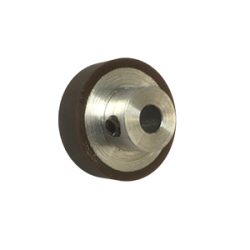Principle of cylindrical grinding of elastomers
Cylindrical grinding is a finishing process that uses an abrasive wheel to smooth the external surface of a cylindrical rubber part. This process is commonly used to improve the dimensional precision and surface quality of rubber parts.
Before grinding, several steps are necessary:
- Preparation of the rubber
- Preparation of the inserts for bonding
- Elastomer overmolding on the inserts
Semi-automatic grinding process

Fully automatic grinding process

Advantages of cylindrical grinding of elastomers:
Some examples of Chevalier, Cleret, Eltec products

Overmolded aluminium roller - Pu

Overmolded roller stainless steel - Silicone

Overmolded roller stainless steel – CR
Function of rollers
they are used to guide and/or print
Lean more about elastomer grinding
Don’t hesitate to contact us using the form if you have any questions or a project to complete.

